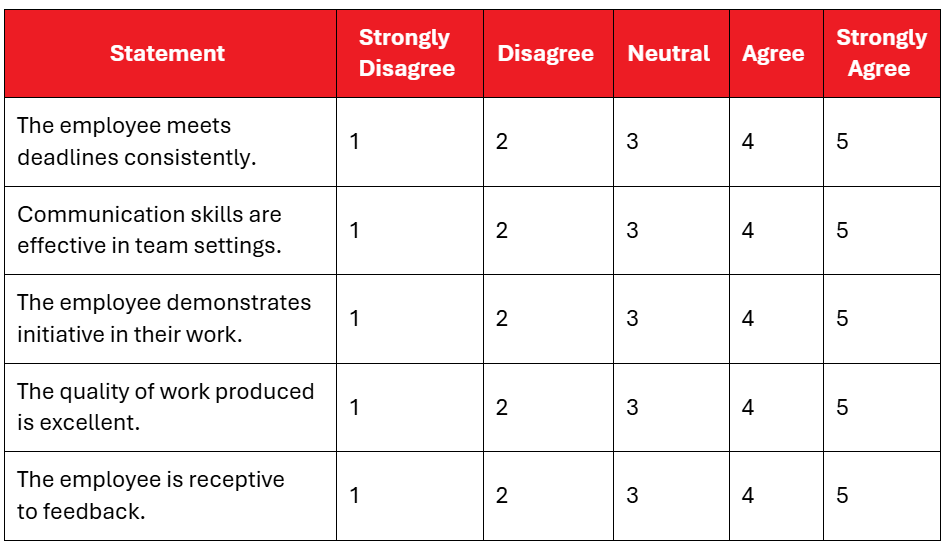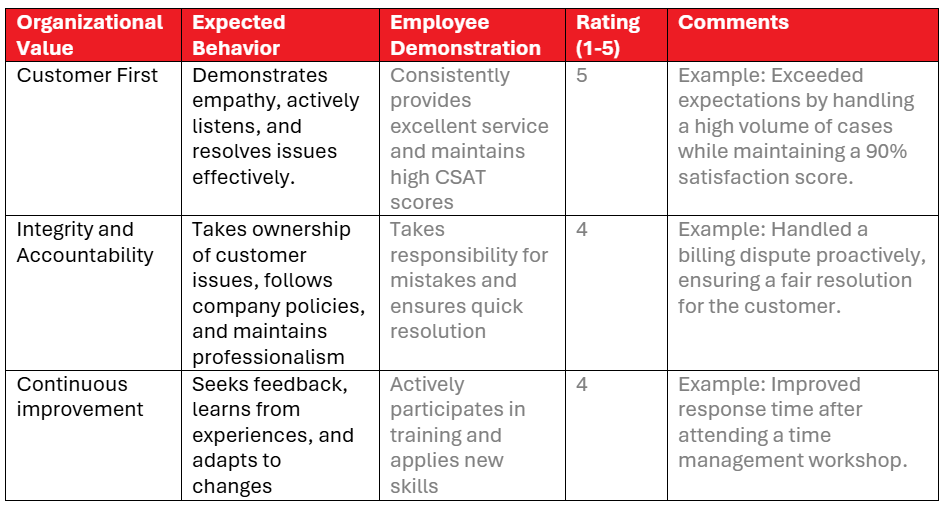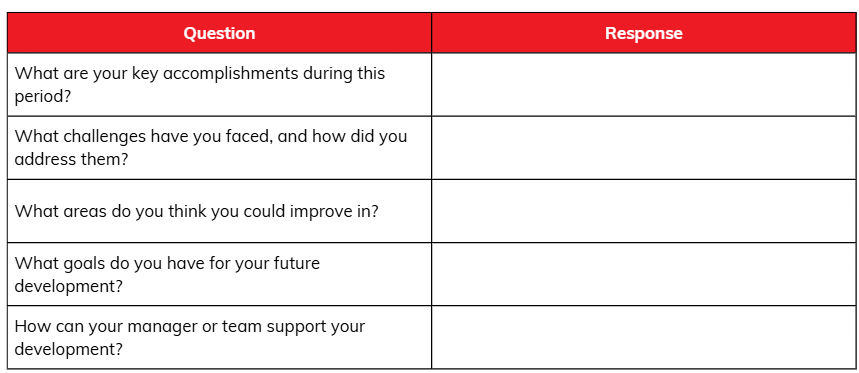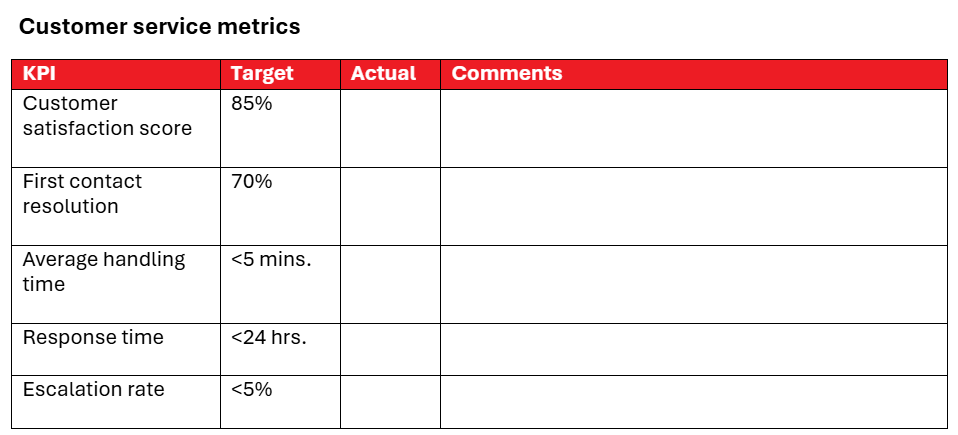
Looking for the perfect template for performance review? This guide provides a structured, easy-to-use format to boost engagement and feedback effectiveness

Performance reviews can be stressful for both managers and employees, especially without a clear structure. A performance review template provides a consistent framework, ensuring fair and organized discussions.
With a structured approach, managers can confidently deliver feedback. Employees can better prepare, making the process more productive and less stressful.
In this article, we’ll go over what makes for a good performance review template. We’ll show some sample formats, key elements, and best practice for HR leaders in drafting these templates. The end goal? Make the feedback process easier for managers and their teams.
A good template for performance reviews contains basic information such as:
Next comes a review of the employee’s performance using:
rating scale – a structured scale (such as a Likert scale, see example below) is commonly used to assess performance levels

open-ended feedback – a narrative section for sharing insights on performance
To complete the performance review template, it should include:
Your template should also include a section covering competencies and behaviors shown by the employee that align with organizational values. Here’s an example. The first two columns are pre-filled, while the other columns are completed by the manager:
When drafting templates, the type and frequency of performance reviews is the main factor. The most common are:
Let’s go over them in a bit more detail:
Annual reviews are done by larger, usually older, companies with established structures and systems. They usually involve a meeting between the manager and direct report at the start of the year to set goals. The next session takes place at the end of the year, when they both look back at the employee’s performance.
Because formal meetings happen at the start and at the end of the year, objectives are set for the long term.
Studies have shown that yearly reviews are the least effective. Employees respond better to more frequent feedback, making them four times more likely to be engaged.
These types of performance evaluations happen at the six-month mark. This frequency allows employees to make adjustments in their work based on the feedback they receive. It also gives them enough time between assessments to make progress towards their goals.
This is at a slightly better rhythm than yearly reviews. There’s enough scope covered without overwhelming managers and employees.
These types of assessments take place once every three months, resulting in more frequent dialog between manager and employee. Also, goals can be changed based on shifting priorities within the organization.
Many organizations are now shifting to regular, continuous feedback. These are also called check-ins or touchpoint meetings.
Continuous feedback involves short meetings (15 to 30 minutes) held weekly or monthly. Employees get real-time feedback on their work, allowing them to course-correct quickly.
These regular chats lead to stronger rapport between managers and their team members. This strengthens team bonds, fostering a positive work culture.
Because continuous feedback is more light touch, the template is more basic and straightforward.
This type of review involves an employee doing an assessment of their work during the reporting period. It will involve a good degree of self-reflection. Some open-ended questions with a scale grading are a good format for employees.
This type of template for performance review can include some of these self-evaluation examples.
Here’s a section of a self-assessment that prompts the employee to reflect on their past performance:
This format is used when a colleague shares feedback on another employee. Gathering feedback from others is part of the 360-degree performance feedback process.
Finding out from their peers how a team member works gives managers a fuller view of their performance. This allows for a more holistic assessment.
There are several points to consider when preparing a template for performance review:
Some questions to ask as part of your decision-making:
Design a template that aligns with company culture and supports both employee growth and business goals.
A good performance review template is fit for purpose, meaning:
The performance review layout would contain elements we discussed in the earlier section.
Include metrics and behavioral competencies. Add a short set of instructions to remind users of points to remember when completing the form.
For example, if the template for performance review refers to SMART objectives, have a one-liner to describe what it stands for: 
Encourage self-reflection
Add a self-assessment section to encourage employees to reflect on their performance. Include a section for manager comments.
Adapt the performance review template to the industry that your company is in. For example, performance reviews for sales teams would include metrics like targets met or new deals closed. Customer service teams, meanwhile, would focus on customer satisfaction KPIs. Here’s a sample snapshot:

Check that the performance review templates are aligned with local labor laws. A poorly designed template could expose you to legal risks, especially in termination or promotion cases. Consult a labor and employment lawyer on this matter.
If you’d like to consult with other HR leaders, reach out to any of the top HR executives in the world for advice.
These templates need to be:
A lot of thought goes into performance reviews, but completing the form should be easy, quick and intuitive. Consider speaking to an expert in design or user experience to maximize the use of these templates.
While performance review templates are essential, digitizing the process is the next step. An HR information system (HRIS) helps keep performance reviews secure, organized, and easy to access.
When choosing an online performance review tool, look for:
If the software has a mobile app version, it may be a good choice for your remote and hybrid teams.
Preparing a performance review format for managers and employees helps lend structure to the appraisal process. Every choice you make in designing this template will help and guide your managers and their teams.
Here are other reasons why managers need a format for performance review:
Having a framework to follow lessens the worry that managers face in handling performance reviews. This is especially helpful to new managers who have never dealt with employee assessments before.
Having a template helps managers lead appraisal meetings with a bit more confidence. In this video, see how the manager uses the performance review template as a guide in her conversation:
Read about the trends and challenges of performance reviews in this article.
Having a standard template helps guarantee that every employee is assessed using the same criteria. Without one, managers might focus on different aspects of the job for different employees.
Using the same template for employees helps uphold fairness in the organization.
Having a standard employee appraisal template determines early on which aspects of the employee’s performance will be discussed. It sets some expectations for the manager and their team member.
A well-designed template is a time saver. Likert scales and pre-defined sections help managers complete the form more efficiently.
A standardized template leads to proper documentation of performance reviews. This, in turn, helps HR teams track employee progress. Using the same form across the organization helps with making data-driven decisions.
A good performance review template can provide much-needed structure to employee appraisal meetings. It serves as a guide for managers and helps lend a degree of predictability to what can be a stressful conversation at work.
Choose a template or format based on the purpose and frequency of performance appraisals at your organization. Yearly reviews call for more detailed templates, while more frequent check-ins are simpler and more straightforward.
The type of template you choose can have a lasting impact on the performance review process. We hope that this guide can help you make the right choice – for your organization, your managers, and the rest of your workforce.
Which template for performance review works best for your organization? Let us know in the comments below